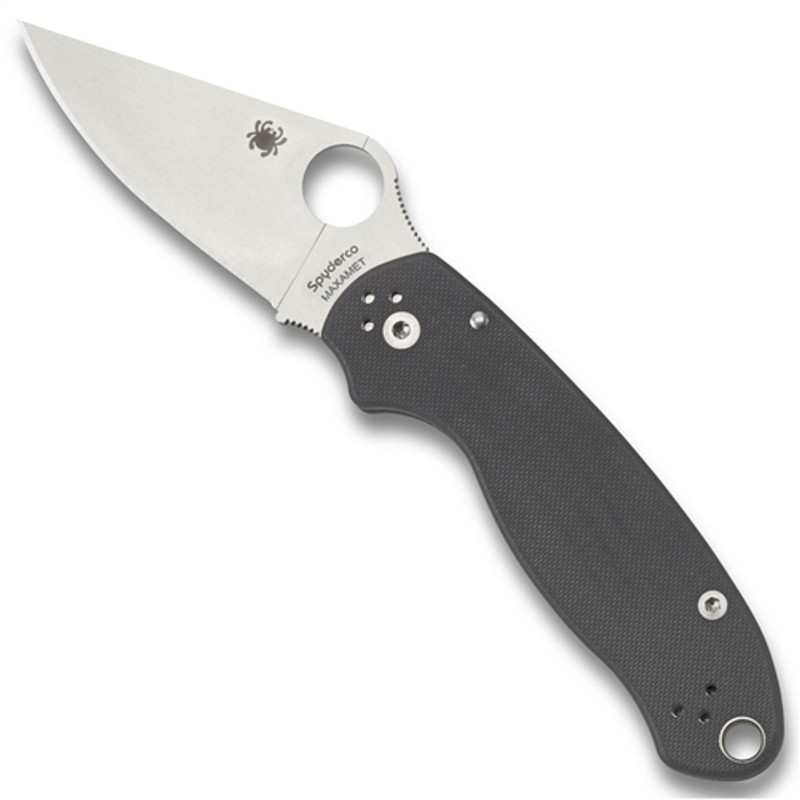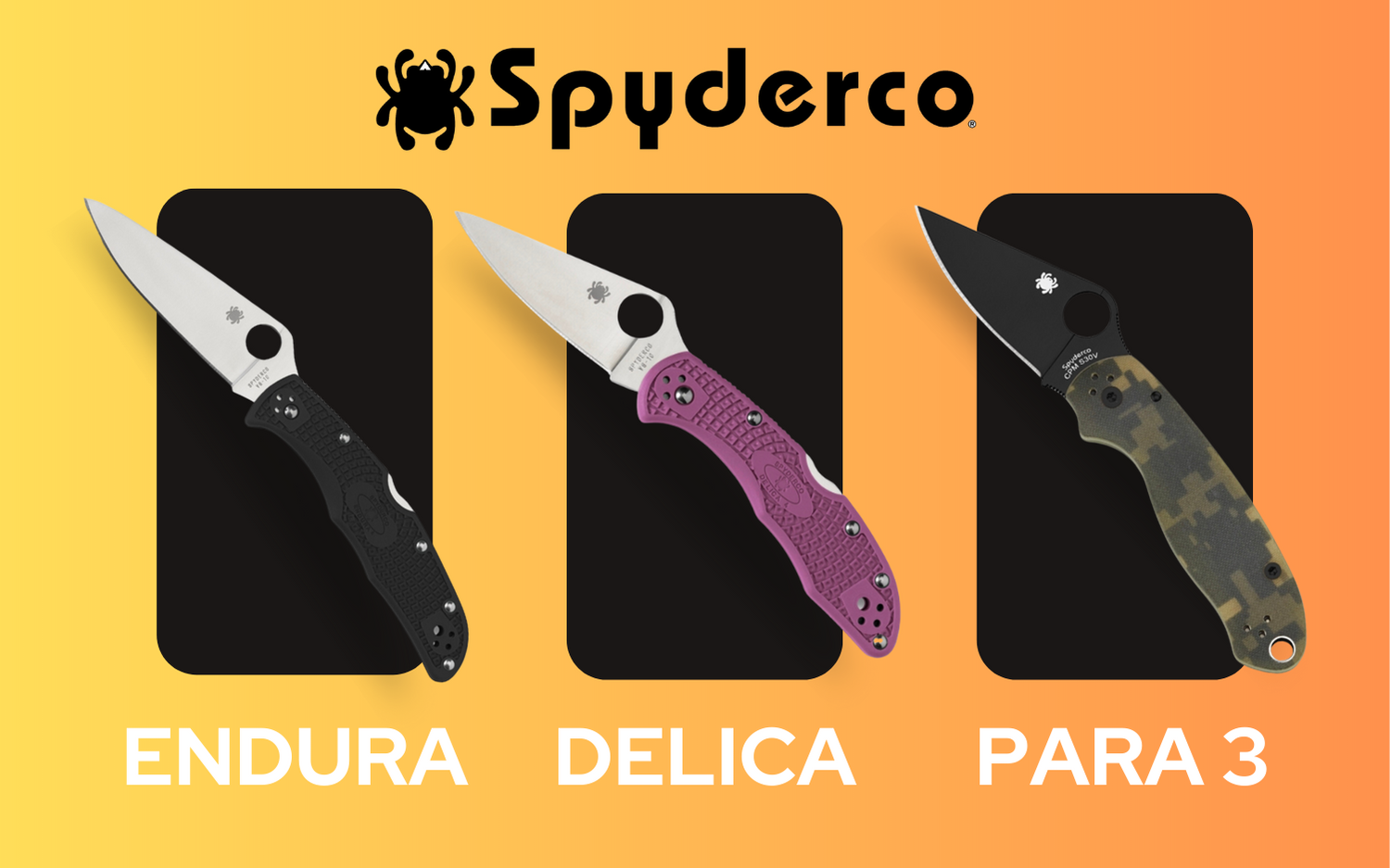Spyderco Delica vs Endura vs Para 3
Posted by TN on Apr 30th 2023
About Spyderco
Spyderco Knives was founded in 1976 by Sal Glesser and his wife Gail. The name came from a spider-shaped device they made called the Portable Hand, which was designed for jewelers, machinists, and hobbyists to hold small parts with alligator clips and multiple ball joints with a magnifying glass and Glesser noticed the fact that many European high-performance cars at the time were named “Spyder”. The Glessers bought an old bakery truck, which they converted into a motor home in order to travel to various trade shows across the US to sell their product.
By 1978, the Glessers decided to settle in Golden, Colorado, where they opened a dedicated factory and developed an effective knife sharpening system. By 1981, they began making knives. The first model was a lock-back folder called the C01 Worker. It featured a pocket clip and a large round hole in the blade to facilitate easy opening. The hole has since become a company trademark.
The company’s designs included fully serrated blades as well as plain edge and partially serrated blades, this is known as the SpyderEdge. In the years since, Spyderco has grown by leaps and bounds bringing forth knife models based on traditional ethnic designs as well as collaborations with custom knife makers including Bob Terzuola, Ken Onion, Ernest Emerson, Ed Schemmp, Fred Perrin, and numerous others. Their catalog runs the gamut from kitchen knives to EDC (Everyday Carry) knives, tactical knives, fixed blade field knives, axes, tomahawks, and of course, knife sharpeners.
Three of their most popular and best-selling pocket knife designs are the Delica, Endura, and Para 3.
What’s The Difference: The Spyderco Delica, Endura, and Para 3
All three knives share a few similarities, notably the round hole in the blade to facilitate one-handed opening, but also have their differences.
Released in 1990, the Spyderco Delica model has evolved over the past 30 or more years. Initially, the handles were black FRN (Fiberglass Reinforced Nylon) but they can be found with other handle colors and at times materials in small sprint runs. The blade is constructed from VG-10 steel and is flat ground and saber ground. The edge can be either plain, fully serrated, or the combo SpyderEdge. The Delica is made in Japan and has a 2.75-inch blade and is 7 inches overall when opened. Original versions of this knife were only available with a blade that carried tip-down due to the positioning of the pocket clip. The most recent version (Delica 4) has a clip that can be positioned in 4 different locations allowing for tip-up or tip-down carry on the right-hand side or the left-hand side
The Spyderco Endura is slightly longer than the Spyderco Delica. Also released in 1990 with black FRN handles, this model has also gone through an evolutionary process similar to the Delica and has kept pace with similar changes and upgrades. The blade length is 3.8 inches with an overall length of 8.75 inches. The current version, Endura 4, also has the 4-position clip like the Delica, and also like the Delica it is made in Japan.
While these two knives may be extremely similar the Para 3 departs a little bit from them from a design perspective The Para 3 is a scaled-down version of Spyderco’s Para Military 2 model, it also has slightly different lines that makes it less tactical focused and more useful as an EDC style knife. It is made in the USA at Spyderco’s Golden, Colorado facility, and the blade on the standard model is machined from premium CPM S45VN stainless steel. The Para 3’s blade is 3 inches in length and has a full flat saber grind. There is a textured thumb ramp and finger choil to aid in retention in the hand as well as blade control for fine-cutting chores. It departs from the Delica and Endura in its handle construction using textured G10 scales and stainless steel liners as well as a compression lock located in the spine of the handle. Like the Delica and Endura, it features a 4-position clip.
Blade Steel and Materials
The Delica and Endura feature Japanese VG-10 stainless steel in their blade construction. The American-made Para 3 uses CPM S45, a premium super steel made in the US. The two steels are comparable with regard to edge retention and corrosion resistance but CPM S45 is a little bit more durable.
Likewise, when it comes to handle materials, the Delica and Endura rely on FRN handles whereas the Para 3 is G10 scales over stainless liners. G10 may not be mammoth ivory or carbon fiber, but it is a definite step up from FRN.
The standard finish on these blades is plain steel, but variants are offered with different colored blade coatings from time to time.
Blade Shape
All three knives have a very similar blade shape and profile. Full flat saber ground blades allow for ease of maintenance. They are easy to maintain their edges in this regard. Although the VG-10 steel used in the Delica and Endura is easier to sharpen than the Para 3 with its CPM S45 blade.
There are also versions of the Delica and Endura that use a Wharncliffe-type blade. The top of the blade is rounded and it lacks the more aggressive tip of the standard model.
Handle Design
The Delica and Endura use FRN handles that are nicely textured, although there are versions of both made with stainless steel or titanium handles without the molded-in texturing of the FRN handles. As mentioned previously, the Para 3 features a handle of textured G10 over stainless steel liners and is slightly longer from front to back. All three knife models feature lanyard holes for securing a lanyard to the knife.
Locking Mechanism
All three models feature a lock on the spine of the handle. In the case of the Delica and Endura, this is a simple lock back or back lock mechanism common to most pocket knives for most of the twentieth century. The Para 3 uses a compression lock which operates more like a Walker liner lock with regard to closing the lock.
Size
All three of these knives are average-sized, maybe a bit smaller when compared to the typical tactical knife. The handles are relatively slim. The Delica sports a 2.75-inch blade with a 7-inch overall length and weighs 2.4 ounces. The Endura has a 3.8-inch blade with an overall length of 8.75 inches and a weight of 3.4 ounces. The Para 3 has a 3-inch blade a 7.25-inch overall length and weighs 2.5 ounces.
They may not seem like huge differences between the three designs, but they are there.
Carry Options
Like most of Spyderco’s folding knives, each one is intended to be carried by means of a long pocket clip that can be positioned on the right side or the left side in either the tip-up or tip-down positions. These knives can be clipped to MOLLE vests, clipped to the waistband, pants pocket, or shirt pocket, or carried in an aftermarket sheath as well.
Prices
Pricewise the Delica and Endura are similar ranging from $126 to $136 respectively as suggested retail prices set by Spyderco. The Para 3 reflects its American manufacture and materials with an MSRP between $200 and $250. Sometimes these models can be found cheaper when on sale, but more often than not, a high demand for the Para 3 may bring an additional premium. There may be an upcharge for rare colors or in the case of the Delica or Endura special runs with titanium handles and stainless Damascus steel blades.
Which Is the Best Quality Knife?
All Spyderco knives represent world-class quality, whether they are made in the US or overseas. Of these three, however, the Para 3 probably exhibits the best craftsmanship and construction, particularly due to the use of stainless liners, CPM S45 steel, and G10 scales. Plus, it is 100% made in the US.
Which Spyderco Knife is Best For You?
If a larger or longer blade appeals to you, the most, the Endura may be what you are looking for. It is just an inch or so longer than the Delica or Para 3, but depending on task requirements and local laws, that may be what you need.
Some folks prefer the slightly smaller Delica as their favorite knife. A small knife on the slightly less expensive side may make a lot more sense, depending on how you use your knife.
Lastly, if you pride yourself on higher-end, all USA-made production knives, the Para 3 might be just the ticket. Some folks with larger hands appreciate the more substantive feel of the Para 3 over the Delica and Endura models. The really significant difference here, though will be the higher price, although the Para 3 has a lot of features packed into its smaller size.
Whether you’re a police officer, military operator, hunter, fisherman, outdoorsman, laborer, or office worker; almost any of Spyderco’s knives will meet all your current needs at home, in the field, or at the office.
Shop BladeOps for high-quality Spyderco knives! From automatic knives, spring assisted knives, to fixed blades, we have what you need for your next knife purchase. Contact our team with any questions.
This article is reviewed by Trevor Darby, MBA, MBC.
Trevor Darby is a book author and freelance writer as well as owner-operator of a leading knife shop in the United States for the past fifteen years. He has designed several knives and is an authority in the field of specialty knives in the US.
Raised in Hollister, CA, he now lives in South Jordan, UT with his wife and two of their six children. He spends his spare time whittling and writing.


